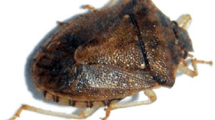Abstract
The chemical and nutritional composition of theaerial parts of Amaranthus muricatus wasassessed. This is a wild plant growing well in aridand poor soil, which are not suitable for cereals. Thematerial under study was boiled, dried and ground andthen evaluated for chemical, nutritional andantinutritional properties. Protein concentration ofthe amaranth flour was 15.74 g/100 g and total dietaryfiber content was high (53.81 g/100 g), with 79%coming from insoluble dietary fiber. The calciumcontent was 1533 mg/100 g and the Ca/P ratio (5.94)was markedly higher than the value suggested in the1989 Recommended Dietary Allowances. Fifty-ninepercent of the fatty acids present were unsaturatedwith linoleic acid accounting for 40% of the totalfatty acid content. Nitrate, hemagglutinin, trypsininhibitor and saponin contents were within thenon-critical values. Net protein utilization (NPU),true digestibility (tD) and biological value (BV)measurements indicated a nitrogen gain of 74% that ofcasein. The results of this study indicate a nutritivepotential for the A. muricatus leaves, therefore,domestication of this plant is suggested along withassessment of its chemical and nutritionalproperties.
Similar content being viewed by others
References
Grubben GJH (1976) The cultivation of amaranth as a tropical leaf vegetable with special reference to south. Dahomey Amsterdam Royal Tropical Institute, pp 32–50.
Ramos N, Curbelo F (1997) Efecto del momento de cosecha en la producción de forraje y calidad del amaranto (Amaranthus cruentus) cv. Morelos. Rev cubana Cienc Agríc 31: 201–207.
Robinson DS (1991) Bioquímica y valor nutritivo de los alimentos. Zaragoza. España. Edit. Acribia S.A., pp 135.
Parodi LR (1964) Enciclopedia Argentina de Agricultura y Jardinería. Buenos Aires. Edit. ACME S.A.C.I., pp 243.
Association of Official Agricultural Chemists (1990) Official Methods of Analysis of the AOAC. 15th ed. Arlington, Virginia: Association of Official Analytical Chemists.
Stuffins CB (1967) The determination of phosphate and calcium in feeding stuff. Analysts 92: 107–113.
Welcher FJ (1966) Standard Methods of Chemical Analysis. Vol. III B. Instrumental Analysis. 6th ed. New Jersey: Ed. D. Van Nostrand Company, Inc., pp 110.
Jacobs MC (1973) The Chemical Analysis of Foods and Food Products. New York: Krieger Publishing Co., Inc., pp 34.
Prosky L, Asp NG, Schweizer TF, De Vries JW, Furda Y (1988) Determination of insoluble, soluble and total dietary fiber in foods and food products. J Assoc Off Anal Chem 71: 1017–1023.
Stanbie DR, Brownsey M, Crettaz M, Denton RM (1976) Acute effects in vivo of antiinsulin activities serum on rates of fatty acids synthesis and activities of acetyl-coenzyme A carboxylase and pyruvate dehydrogenase in liver and epididymal adipose tissue of fed rats. Biochem J 160: 413–416.
EPA (1980) Analysis of Pesticide Residues in Human and Environmental Samples. A Compilation of Methods Selected for Use in Pesticide Monitoring Programs. 600/8-80-038. Health Effects Research Laboratory (MD-69). Research Triangle Park, North Carolina 27711.
Cataldo DA, Haroon M, Schrader LE, Youngs VL (1975) Rapid colorimetric determination of nitrate in plant tissue by nitration of salicylic acid. Commun Soil Sci and Plant Anal 6: 71–80.
do Prado VC, Antunes PL, Sgarbieri VC (1980) Antinutrients occurrence and some physicochemical properties of the protein fractions of five Brazilian soybean varieties. Arch Latinoamer Nutr 30: 551–563.
Das Gupta BR, Boroff DA (1968) Separation of toxin and hemagglutin from crystalline type A by anion exchange chromatography and determination of their dimension by gel filtration. J Biol Chem 243: 1065–1072.
Kakade ML, Rackis JJ, McGhee JF, Puski G (1974) Determination of trypsin inhibitor activity of soy products: A collaborative analysis of an improved procedure. Cereal Chem 51: 376–382.
Duarte Correa A, Jokl L, Carlsson R (1986) Chemical constituents, in vitro protein digestibility and presence of antinutritional substance in amaranth grains. Arch Latinoamer Nutr 36: 319–326.
WHO/PHARM/92559 (1992) Quality Control Methods for Medicinal Plant Materials. 1211 Geneva 27, Switzerland: World Health Organization, pp 36–37.
Miller DS, Bender AE (1955) The determination of the net utilization of proteins by a shortened method. Brit J Nutr 9: 382–388.
Sambucetti ME, Gallegos G, Sanahuja JC (1973) Estudio de la proteína extraída de lino. Valor nutritivo e inocuidad. Arch Latinoamer Nutr 23: 76–94.
Harper AE (1959) Amino acid balance and imbalance. I. Dietary level of protein and amino acid imbalance. J Nutr 68: 405–409.
Arellano ML, Carranco JM, Pérez Gil RM, Hernández PE, Partida IH, Ripoll SH (1993) Estudio de la composición química de seis plantas del Estado de Oaxaca, México, como recursos potenciales en la alimentación animal. Arch Latinoamer Nutr 43: 264–268.
Sánchez Marroquín A (1983) Dos cultivos olvidados de importancia agroindustrial: el amaranto y la quinua. Arch Latinoamer Nutr 33: 11–32.
Robinson DS (1991) Bioquímica y valor nutritivo de los alimentos. Zaragoza. España. Edit. Acribia S.A., pp 278.
Dodok L, Modhir AA, Buchtovà V, Halàsovà G, Polàcek I (1997) Importance and utilization of amaranth in the food industry. Part 2. Composition of amino acids and fatty acids. Nahrung 41: 108–110.
Hill RM, Rawate PD (1982) Evaluation of food potential some toxicological aspects and preparation of a protein isolate from the aerial part. J Agric Food Chem 30: 465–469.
Marques Mendez MH, Casa Nova Derivi S, Fernandez ML, Gomes de Oliveira AM (1993) Insoluble dietary fiber of grain food legumes and protein digestibility. Arch Latinoamer Nutr 43: 66–72.
Author information
Authors and Affiliations
Rights and permissions
About this article
Cite this article
Escudero, N., Albarracín, G., Fernández, S. et al. Nutrient and antinutrient composition of Amaranthus muricatus . Plant Foods Hum Nutr 54, 327–336 (1999). https://doi.org/10.1023/A:1008149721435
Issue Date:
DOI: https://doi.org/10.1023/A:1008149721435




